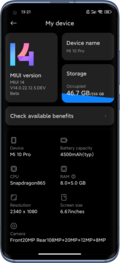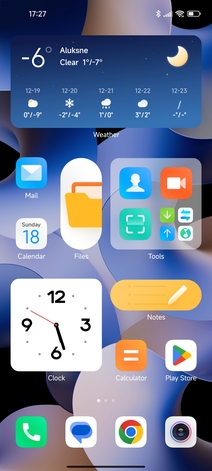MIUI
| Developer | Xiaomi |
|---|---|
| OS family | Android-like OS (Android-based Linux OS) |
| Source model | Open source (Modified Android Base and Main Framework) with Proprietary components (MIUI Apps and Kits)[1] |
| Initial release | 0.8.16 / 16 August 2010 |
| Latest release | Varies by mobile phone and region. |
| Latest preview | V14.0.23.10.8.DEV (Mainland China) / 17 August 2023 |
| Marketing target | Alternative OS replacement for Android devices; Stock firmware for Xiaomi smartphone and tablet |
| Available in | 77 languages (varies by country) |
| Package manager | APK-based |
| Platforms | ARMv7, ARM64, MIPS, x86, x64 |
| Kernel type | Monolithic (modified Linux kernel) |
| License | Proprietary |
| Succeeded by | Xiaomi HyperOS |
| Official website | www home |
MIUI[a] is a deprecated mobile operating system by Xiaomi for its smartphones and devices, from 2010 to 2023,[3][4][5] prior to the launch of its successor Xiaomi HyperOS.[6]
MIUI was based on the Android Open Source Project, and served as the basis for other OS deviations by Xiaomi: MIUI for Poco, MIUI Pad, MIUI Watch, and MIUI TV (PatchWall).[7]
There are different versions for each Xiaomi phone model, and each version has regional variants dependent on where the phone is sold, including China, Europe, Indonesia, India, Japan, Pakistan, Russia, Taiwan and Turkey. Xiaomi have also released a few devices running Google's Android One instead of MIUI. Xiaomi devices usually get three Android version updates, but get MIUI updates for four years (less for budget models).[8]
The first MIUI ROM, released in 2010, was based on Android 2.2.x Froyo and was initially developed in China by Xiaomi in its first year of operation.[9] Xiaomi added a number of apps to the basic framework, including Notes, Backup, Music, and Gallery apps.[10]
An organisation named Xiaomi Europe, using the domain xiaomi.eu and working officially with Xiaomi despite not being affiliated with the Chinese company,[11] was set up in 2010 as a community for English-language Xiaomi users with phones running MIUI associated with an Android version. The website issues its own stable and weekly versions of Xiaomi MIUI ROMs based on the stable, and on the weekly beta versions of the Chinese ROM.[11] Installing the xiaomi.eu ROM, however, voids the warranty on Xiaomi phones; according to the xiaomi.eu leader, the official ROM must be flashed and the bootloader locked before returning a device for warranty repair.[12]
Xiaomi is replacing MIUI with its new Android-based operating system HyperOS, starting with the Xiaomi 13 series and Pad 6.[13]
Google Play services
[edit]Google has had disagreements with the Chinese government, and the Great Firewall currently blocks access to all Google services. Since Xiaomi has expanded its operations outside China, MIUI releases for Android devices outside mainland China have Google Play Services and Google Apps such as Gmail, GMaps, YouTube and Google Play pre-installed and functioning as on any other Android device. MIUI global versions are certified by Google, as are all MIUI devices, which ship with Google Play Services since MIUI 12.5.[14]
Comparison of all MIUI variants
[edit]| China | Global | Xiaomi.eu | ||||
|---|---|---|---|---|---|---|
| Languages available | Few, including Chinese and English | Wide selection | ||||
| Selection of downloadable themes | All | Some | ||||
| Drag up search | Yes
with international Bing and selection of Chinese search engines |
Google App or Mi Browser | Yes | |||
| Smart Assistant | App vault | Google Discover (App Vault in Indonesia, India, Russia and Taiwan) | App vault and Google Discover | |||
| Default source of apps | GetApps | Google Play, Mi Picks/GetApps[15] | Google Play | |||
| Xiaomi Cloud services | All | Some | All | |||
| Updates | Developer | Stable | Beta | Stable | Dev/Beta | Stable |
| No longer available | Usually updated every two months[16] | No longer available | Usually updated every three months | Updated every Friday | Usually updated every two months | |
| OTA | Yes | Yes; patches are not supported, so a complete new ROM is downloaded each time | ||||
| Official | Yes (made by Xiaomi) |
Approved by the official distribution in the European Union.[11] | ||||
| Custom recovery requirement | No | Some (recovery ROMs only) | ||||
| Additional features |
|
Optional access to various Chinese online services | Google apps on some ROMs instead of MIUI apps (Dialer, Messages, Contacts, Calendar) |
| ||
| Supported Xiaomi devices | Majority
excluding devices never released in PRC Older devices may not be updated |
Majority
excluding devices never released outside PRC Older devices may not be updated | ||||
Android
[edit]Although MIUI is built on the Android platform, the default user interface of its earlier iterations resembled iOS due to the absence of the application tray,[17] with a grid of icons arrayed in the home panels. Other iOS similarities include the app icons being in a uniform shape, the dialer and in-call interface, the organization of the Settings app, and the visual appearance of toggles in the UI. This prompted some observers to cite how the devices running on MIUI could appeal to iOS users wanting to switch to the Android platform.[17] By 2018, MIUI was increasingly shifting towards a design aesthetic more similar to stock Android. For instance, several elements in builds of MIUI 10 resemble Android Pie features, such as the multitasking menu and gesture controls.[18] This change was first seen in MIUI 9 (ver. 8.5.11) that shipped with Xiaomi Mi MIX 2S.[19]
Another difference from Android is MIUI's support for themes and custom fonts. Users can download theme packs and fonts, which can change the user interface of the device when installed from the Mi Themes Store. It also allows more advanced users to tweak the hard-coded firmware of the handsets.[20]
Issues
[edit]As MIUI's kernel was proprietary, it was in breach of Linux kernel's GPL.[21][22] The source code of certain components was released to GitHub on 25 October 2013.[23] Kernel sources for a few devices, including the Mi3, Mi4, MiNote, and Redmi 1S, were released in March 2015.[24]
In order to raise funds for the company, MIUI has its own online services from Xiaomi, including cloud services, paid themes and games. Payments are transacted using the Mi Credit digital currency.[25]
After the government of India banned over 100 Chinese apps and services in 2020 due to national security and privacy concerns, including some made by Xiaomi, the company developed a separate MIUI version without them for India.[26][27]
Vulnerabilities
[edit]In April 2019, security researcher Arif Khan reported that Xiaomi's browser apps Mi Browser and Mint Browser suffered from a vulnerability that allowed the URL address bar to be spoofed, which affected Indian as well as certain global versions of MIUI. Xiaomi gave Khan a Bug bounty but opted not to fix this issue.[28][29] In addition, a vulnerability in a wallpaper carousel app Glance on Indian versions of MIUI allowed a user to bypass the lock screen and access clipboard data.[30][31] This vulnerability was eventually fixed by Xiaomi.[31]
Performance issues
[edit]Some users encountered issues such as touch response problems on MIUI 12.5.[32] Users also complain about overheating, slow performance, drop in framerate, unstable app function and files randomly missing from their phone's storage. The update to MIUI 13 brought several performance improvements.[33]
Version history
[edit]| Version | Screenshot | Android version | Date of release | Last Stable release | Initial Beta release | Last Beta release | Notable change |
|---|---|---|---|---|---|---|---|
| MIUI V1 | 2.1 | 16 August 2010 | 0.8.16 | Unknown |
| ||
| MIUI V2 | 
|
2.1-2.3.6 |
Unknown | — | Unknown | Unknown |
|
| MIUI V3 | 2.3.6 | Unknown | — | Unknown | 2.4.20 |
| |
| MIUI V4 | 4.0.4 – 4.1.2 | Unknown | ICS24.0[34] | Unknown | 3.2.22 |
| |
| MIUI V5 | 
|
4.1.2 – 4.4.2 | 1 March 2013[35] | 31.0[36] | 3.3.1 | 4.12.5 |
|
| MIUI 6 | 4.4.2 – 5.0.2 | 29 August 2014[37] | 6.7.2.0 | 4.8.29 | 5.8.6 |
| |
| MIUI 7 | 
|
4.4.2 – 6.0.1 | 13 August 2015[38] | 7.5.9.0 | 5.8.12 | 6.5.26 |
|
| MIUI 8 |  |
4.4.2 – 7.1.2 | 16 June 2016[39] | 8.5.10.0 | 6.6.16 | 7.7.20 |
|
| MIUI 9 |  |
4.4.2 – 8.1.0 | 10 August 2017 | 9.6.5.0 | 7.8.10 | 8.5.24 |
|
| MIUI 10 | 6.0 – 9 | 19 June 2018[40] | 10.4.5.0 | 8.6.14 | 9.9.6 |
| |
| MIUI 11 |  |
7.0 – 10 | 22 October 2019 | 11.0.14.0 | 9.9.24 | 20.3.26 |
|
| MIUI 12 |  |
9 – 11 | 27 April 2020 | 12.2.7.0 | 20.4.27 | 20.12.10 |
|
| MIUI 12.5 |  |
10 – 12 | 28 December 2020 | 12.5.26.0 | 20.12.25[43] | 21.7.5 |
|
| MIUI 13 |  |
11 – 13 | 28 December 2021 | 13.2.8.0 (Mainland China) 13.2.6.0 (Global Market) |
21.7.6[44] | 13.1.22.10.25.DEV (Android 13 Weekly) 13.1.22.10.24.DEV (Android 12 Weekly) 22.11.23 (Daily Beta for some devices) 22.10.26 (Daily Beta) |
|
| MIUI 14 |  |
12 – 14 | 11 December 2022[46] | 14.1.10.0 | 14.0.22.12.5.DEV | 14.0.23.10.8.DEV |
|
See also
[edit]- List of custom Android distributions
- Comparison of mobile operating systems
- List of free and open-source Android applications
Notes
[edit]References
[edit]- ^ "Mi OpenSource". github.com.
- ^ About MIUI Video on YouTube
- ^ Xiaomi 13 Quick Start Guide
- ^ "小米科技的MIUI和手机_通讯与电讯_科技时代_新浪网". tech.sina.com.cn. Archived from the original on 2 February 2019. Retrieved 24 April 2012.
- ^ MIUI Official English Site, en.miui.com, archived from the original on 15 February 2014, retrieved 16 March 2014
- ^ "Xiaomi HyperOS".
- ^ Xiaomi Mi Watch is unapologetically inspired by the Apple Watch, but costs only $185
- ^ Xiaomi Phone with MIUI OS: a $310 Android with 1.5 GHz dual-core SoC and other surprises, Engadget, 16 August 2011, archived from the original on 23 September 2011, retrieved 17 September 2011
- ^ Jason Lim (14 April 2011), MIUI, Lei Jun, TechNode, archived from the original on 2 April 2019, retrieved 17 January 2012
- ^ "MIUI Official English Site". Archived from the original on 9 April 2014. Live version for current MIUI; archived version for MiUI 5.
- ^ a b c "Home page, with 'About us' and forum list". Xiaomi European Community. Archived from the original on 27 April 2021. Retrieved 22 June 2023. Updated frequently.
- ^ ingbrzy, Xiaomi.eu ROM leader (24 January 2021). "Answer to: Do I have warranty after flashing xiaomi.eu?". Xiaomi European Community. Archived from the original on 28 April 2021.
- ^ "Xiaomi HyperOS". Xiaomi. Retrieved 8 November 2024.
- ^ "Android – Certified - Partners". Android. Archived from the original on 24 June 2020. Retrieved 31 January 2020.
- ^ Forum, Xiaomi MIUI Official. "Mi Picks - pick your next favorite- officially launched! Give us your feedback! - App - Xiaomi MIUI Official Forum". en.miui.com. Archived from the original on 29 September 2019. Retrieved 15 February 2018.
- ^ "MIUI ROM Downloads". en.miui.com. Archived from the original on 2 April 2019. Retrieved 28 April 2018.
- ^ a b Black, Marie. "What's the difference between TouchWiz, MIUI, EMUI, OxygenOS, LG UX and standard Android?". Tech Advisor. Archived from the original on 2 June 2020. Retrieved 31 July 2018.
- ^ "MIUI 10 To Offer Updated Design, Its User Interface Leaks | Androidheadlines.com". AndroidHeadlines.com |. 29 May 2018. Archived from the original on 4 August 2020. Retrieved 31 July 2018.
- ^ "Latest MIUI 9 build for the Xiaomi Mi Mix 2 brings Android P-style UI changes". xda-developers. 11 May 2018. Archived from the original on 4 August 2020. Retrieved 31 July 2018.
- ^ Pfeffermann, Nicole; Gould, Julie (2017). Strategy and Communication for Innovation: Integrative Perspectives on Innovation in the Digital Economy. Cham, Switzerland: Springer. p. 30. ISBN 9783319495408.
- ^ "小米的MIUI被指违反GPL许可证" (in Chinese). Solidot. 21 November 2012. Archived from the original on 8 June 2019. Retrieved 6 August 2013.
- ^ "MIUI is accused of non-compliance with free software license, users request MIUI to be free software (MIUI被指责不遵守开源软件协议,网友要求公开源代码)" (in Chinese). tech2ipo. 21 November 2012. Archived from the original on 3 March 2016. Retrieved 6 August 2013.
- ^ "Commits". GitHub. 25 October 2013. Archived from the original on 4 April 2019. Retrieved 27 January 2014.
- ^ GitHub MiCode/Xiaomi_Kernel_OpenSource, GitHub, 31 March 2015, archived from the original on 5 April 2019, retrieved 8 April 2015
- ^ "删除谷歌,内置杀毒,MIUI终于突破底线". Archived from the original on 2 April 2019. Retrieved 9 April 2013.
- ^ Wright, Arol (8 August 2020). "Xiaomi is rebuilding MIUI for India without any of its banned apps". xda-developers. Archived from the original on 8 August 2020. Retrieved 8 August 2020.
- ^ "Xiaomi India working on new MIUI version without banned Chinese apps". Android Police. 7 August 2020. Archived from the original on 29 August 2020. Retrieved 8 August 2020.
- ^ Akolawala, Tasneem (5 April 2019). "Xiaomi's Mi Browser, Mint Browser Said to Contain Critical URL Spoofing Security Vulnerability". NDTV. Archived from the original on 27 November 2020. Retrieved 28 November 2020.
- ^ Merchant, Zaheer (8 April 2019). "Xiaomi warned about critical flaw in its two Android browsers but does nothing". MediaNama. Archived from the original on 28 November 2020. Retrieved 28 November 2020.
- ^ "[Unpatched Vulnerability] CVE-2019-11015: Lock Screen Auth Bypass leading to Sensitive Information Disclosure and an Improper Access Control issue in Xiaomi MIUI OS (latest stable releases affected) - Andmp | A blog about infosec, bug hunting and more!". www.andmp.com. Archived from the original on 7 December 2020. Retrieved 28 November 2020.
- ^ a b Singh, Jagmeet (17 April 2019). "MIUI Lock Screen Vulnerability Provided Access to Clipboard Data, Fix Released". NDTV. Archived from the original on 7 December 2020. Retrieved 28 November 2020.
- ^ Udin, Efe (24 June 2021). "MIUI global users complain of touch-screen issues". Gizchina.com. Retrieved 23 September 2022.
- ^ Chawake, Anurag (4 July 2022). "Xiaomi MIUI 13 update bugs, issues, & problems tracker [Cont. updated]". PiunikaWeb. Retrieved 23 September 2022.
- ^ "MIUI Official English Site - Redefining Android". 6 December 2013. Archived from the original on 6 December 2013. Retrieved 22 May 2018.
- ^ Forum, Xiaomi MIUI Official. "MIUI ROM 3.3.1 Changelog: MIUI V5 for Xiaomi MI2 Released!!! - MIUI General - Xiaomi MIUI Official Forum". en.miui.com. Archived from the original on 11 February 2017. Retrieved 10 February 2017.
- ^ Forum, Xiaomi MIUI Official. "MIUI Stable ROM (Global) KXDMIBF22.0 for MI3-WCDMA/CDMA Changelog & Download - Xiaomi Mi 3 - Xiaomi MIUI Official Forum". en.miui.com. Archived from the original on 6 May 2018. Retrieved 5 May 2018.
- ^ Forum, Xiaomi MIUI Official. "MIUI ROM 4.8.29 Full Changelog. MIUI 6 Released for Public! (Released) - MIUI General - Xiaomi MIUI Official Forum". en.miui.com. Archived from the original on 11 February 2017. Retrieved 10 February 2017.
- ^ Forum, Xiaomi MIUI Official. "About MIUI 7 China ROM 5.8.13. What Device Will MIUI 7 Global ROM Support First? - MIUI General - Xiaomi MIUI Official Forum". en.miui.com. Archived from the original on 11 February 2017. Retrieved 10 February 2017.
- ^ Forum, Xiaomi MIUI Official. "MIUI 8 China Developer ROM 6.6.16 Full Changelog & Supported Devices - MIUI General - Xiaomi MIUI Official Forum". en.miui.com. Archived from the original on 11 February 2017. Retrieved 10 February 2017.
- ^ "MIUI 10首批机型公测下载 - MIUI官方网站". www.miui.com. Archived from the original on 21 August 2017. Retrieved 21 June 2018.
- ^ "MIUI 11 will introduce new icons, ultra power saving mode, and more". 29 March 2019. Archived from the original on 24 August 2021. Retrieved 5 April 2019.
- ^ "MIUI 12.1 coming soon. Here are all the what's new! - Tech in Deep". www.techindeep.com. 15 July 2020. Archived from the original on 24 August 2021. Retrieved 2 August 2020.
- ^ "MIUI 13 - The Best MIUI Ever – Posts - Facebook". www.facebook.com. Retrieved 29 December 2022.
- ^ "Xiaomi MIUI 13 update allegedly begins testing with beta version 21.7.6". piunikaweb.com. 6 July 2021. Retrieved 29 December 2022.
- ^ "MIUI Notes App has changed completely on MIUI 13!". www.xiaomiui.net. Archived from the original on 26 March 2022. Retrieved 9 April 2022.
- ^ "MIUI 14 锐意新生". home.miui.com. Retrieved 9 December 2023.


